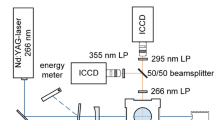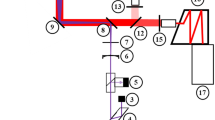Abstract
Dynamic quenching of fuel fluorescence by ketone dopants in liquid phase is investigated to suggest an optical method for two-phase flow visualization in a liquid-fueled combustor. The fuel fluorescence is triggered by high peak-power 266 nm laser pulses. It is found that ketones can serve as quenchers absorbing the fluorescence of a widely used liquid fuel, exo-THDCPD (exo-tetrahydrodicyclopentadiene). The impact of the dynamic quenching on the fuel fluorescence is validated under various ambient temperature conditions to simulate two-phase fuel flows in preheated ambient air. The signal intensity ratio with and without the dopants (quenching ratio) is below 0.4 % near 290 nm when the ketone concentration in the mixture is 5 %, while the quenching effect is insignificant in the spectral range above 325 nm. As a result, the proposed technique is successfully demonstrated in a model supersonic combustor, delineating vapor-dominant regions in the two-phase supersonic flows.
Similar content being viewed by others
References
Z. Ren, B. Wang, G. Xiang, D. Zhao and L. Zheng, Supersonic spray combustion subject to scramjets: progress and challenges, Progress in Aerospace Sciences, 105 (2019) 40–59.
S. Huang, P. Deng, R. Huang, Z. Wang, Y. Ma and H. Dai, Visualization research on spray atomization, evaporation and combustion processes of ethanol-diesel blend under LTC conditions, Energy Conversion and Management, 106 (2015) 911–920.
K. Sakaki, H. Kakudo, S. Nakaya, M. Tsue, K. Suzuki, R. Kanai, T. Inagawa and T. Hiraiwa, Combustion characteristics of ethanol/liquid-oxygen rocket-engine combustor with planar pintle injector, Journal of Propulsion and Power, 33 (2) (2017) 514–521.
Y.-H. Wang, W.-Y. Song and D.-Y. Shi, Experimental study of flame stabilization in a kerosene fueled scramjet combustor, Acta Astronautica, 157 (2019) 282–293.
M. Kim and K. T. Kim, Experimental investigation of low-frequency instabilities of dual-swirl pressure-atomization spray flames, Journal of Mechanical Science and Technology, 36 (7) (2022) 3501–3508.
J. Yoon, K. Myong, J. Senda and H. Fujimoto, Analysis of spatial vapor-phase distribution using the LIF method on multi-component fuel, Journal of Mechanical Science and Technology, 23 (2009) 2565–2573.
M. Andersson, J. Warnberg, S. Hemdal, P. Dahlander and I. Denbratt, Evaporation of gasoline-like and ethanol-based fuels in hollow-cone sprays investigated by planar laser-induced fluorescence and mie scattering, SAE Technical Paper (2011) 2011-01-1889.
S. Parrish and R. Zink, Development and application of a high-speed planar laser-induced fluorescence imaging system to evaluate liquid and vapor phases of sprays from a multi-hole diesel fuel injector, Measurement Science and Technology, 24 (2) (2012) 025402.
D. Shin, A. Satija and R. P. Lucht, Spray characteristics of standard and alternative aviation fuels at high ambient pressure conditions, Experimental Thermal and Fluid Science, 130 (2022) 110511.
M. Zaller, R. Locke and R. Anderson, Comparison of techniques for non-intrusive fuel drop size measurements in a sub-scale gas turbine combustor, Journal of Visualization, 2 (3–4) (2000) 301–308.
A. Charogiannis and F. Beyrau, Laser induced phosphorescence imaging for the investigation of evaporating liquid flows, Experiments in Fluids, 54 (2013) 1–15.
A. Douglawi, V. Athmanathan, M. N. Slipchenko, J. R. Gord and T. R. Meyer, Lifetime-filtered laser-induced exciplex fluorescence for crosstalk-free liquid-vapor imaging, Optics Letters, 44 (6) (2019) 1399–1402.
A. Douglawi, A. McMaster, M. E. Paciaroni, J. B. Michael, B. R. Halls, J. R. Gord and T. R. Meyer, Tracer-free liquid–vapor imaging using lifetime-filtered planar laser-induced fluorescence, Optics Letters, 44 (8) (2019) 2101–2104.
L. A. Melton, Spectrally separated fluorescence emissions for diesel fuel droplets and vapor, Applied Optics, 22 (14) (1983) 2224–2226.
L. A. Melton, Exciplex-based vapor/liquid visualization systems appropriate for automotive gasolines, Applied Spectroscopy, 47 (6) (1993) 782–786.
J. Yeom, J. Park and S. Chung, An analysis on structure of impinging and free diesel spray with exciplex fluorescence method in high temperature and pressure field, Journal of Mechanical Science and Technology, 19 (2005) 2281–2288.
J. Yeom, J. Park, S. Kim, J. Ha, S. Chung and J. Lee, A study of the mixture formation process of a diesel spray under phase change, Journal of Mechanical Science and Technology, 21 (2007) 1120–1128.
T. D. Fansler, M. C. Drake, B. Gajdeczko, I. Düwel, W. Koban, F. P. Zimmermann and C. Schulz, Quantitative liquid and vapor distribution measurements in evaporating fuel sprays using laser-induced exciplex fluorescence, Measurement Science and Technology, 20 (12) (2009) 125401.
G. Zhang, D. L. Hung and M. Xu, Experimental study of flash boiling spray vaporization through quantitative vapor concentration and liquid temperature measurements, Experiments in Fluids, 55 (2014) 1–12.
H. Liu, B. Chen, L. Feng, Y. Wang, W. Yi and M. Yao, Study on fuel distribution of wall-impinging diesel spray under different wall temperatures by laser-induced exciplex fluorescence (LIEF), Energies, 11 (5) (2018) 1249.
L. Feng, X. Sun, X. Pan, W. Yi, Y. Cui, Y. Wang, M. Wen, Z. Ming, H. Liu and M. Yao, Gasoline spray characteristics using a high pressure common rail diesel injection system by the method of laser induced exciplex fluorescence, Fuel, 302 (2021) 121174.
I. R. Gould, R. H. Young, L. J. Mueller and S. Farid, Mechanisms of exciplex formation. roles of superexchange, solvent polarity, and driving force for electron transfer, Journal of the American Chemical Society, 116 (18) (1994) 8176–8187.
M. Koch, R. Letrun and E. Vauthey, Exciplex formation in bimolecular photoinduced electron-transfer investigated by ultrafast time-resolved infrared spectroscopy, Journal of the American Chemical Society, 136 (10) (2014) 4066–4074.
I. Düwel, W. Koban, F. Zimmermann, T. Dreier and C. Schulz, Spectroscopic characterization of the fluorobenzene/dema tracer system for laser-induced exciplex fluorescence for the quantitative study of evaporating fuel sprays, Applied Physics B, 97 (2009) 909–918.
J. Desantes, J. Pastor, J. Pastor and J. Juliá, Limitations on the use of the planar laser induced exciplex fluorescence technique in diesel sprays, Fuel, 84 (18) (2005) 2301–2315.
C. Schulz and V. Sick, Tracer-LIF diagnostics: quantitative measurement of fuel concentration, temperature and fuel/air ratio in practical combustion systems, Progress in Energy and Combustion Science, 31 (1) (2005) 75–121.
P. Wu and L. Brand, Resonance energy transfer: methods and applications, Analytical Biochemistry, 218 (1) (1994) 1–13.
R. M. Clegg, Förster resonance energy transfer—FRET what is it, why do it, and how it’s done, Laboratory Techniques in Biochemistry and Molecular Biology, 33 (2009) 1–57.
D. L. Dexter, A theory of sensitized luminescence in solids, The Journal of Chemical Physics, 21 (5) (1953) 836–850.
S. Hassoon, H. Lustig, M. B. Rubin and S. Speiser, The mechanism of short-range intramolecular electronic energy transfer in bichromophoric molecules, The Journal of Physical Chemistry, 88 (25) (1984) 6367–6374.
K. Kroenlein, C. Muzny, A. Kazakov, V. Diky, R. Chirico, J. Magee, I. Abdulagatov and M. Frenkel, NIST/TRC Web Thermo Tables (WTT) NIST Standard Reference Subscription Database 3 - Professional Edition Version 2, NIST/TRC Web Thermo Tables (WTT) - Professional Edition, NIST (2011).
Acknowledgments
This work was supported by the Basic Research Funding of Korean Agency for Defense Development (grant number: UD210021JD, UD210034SD), the Korea Institute of Energy Technology Evaluation and Planning (grant number: 202067 10100030), and the National Research Foundation of Korea (NRF) grant funded by the Korea government (grant number: 2021R1A2C2012697, 2021R1A4A1032023).
Author information
Authors and Affiliations
Corresponding author
Additional information
Seongik Cha is currently a Ph.D. candidate in the Department of Mechanical Engineering at Seoul National University, Seoul, Korea. His research interests include laser diagnostics, supersonic combustion, and hypersonic flow.
Nam Young Kim is currently a Ph.D. candidate in the Department of Mechanical Engineering at Seoul National University, Seoul, Korea. His research interests include supersonic combustion and hypersonic flow.
Inyoung Yang received his Ph.D. degree in Department of Mechanical Engineering at KAIST. He is currently a Principal Researcher of Aero-Propulsion Research Division, Korea Aerospace Research Institute, Daejeon, Korea. His research interests include hypersonic air-breathing propulsion system.
Sanghoon Lee received his Ph.D. degree in 2016 from Hanyang University Seoul, Korea. He is currently a Senior Researcher in Aero-Propulsion Research Division at Korea Aerospace Research Institute (KARI) in Daejeon, Korea. His research interests include hypersonic flow, fuel spray atomization.
Hyungrok Do received his Ph.D. degree in 2009 from Stanford University, California, United States. He is currently a Professor in the Department of Mechanical Engineering at Seoul National University, Seoul, Korea. His research interests include laser diagnostics, hypersonic flow, and turbulent combustion.
Rights and permissions
About this article
Cite this article
Cha, S., Kim, N.Y., Yang, I. et al. Ketone dopant-induced dynamic quenching of liquid fuel fluorescence for two-phase flow visualization. J Mech Sci Technol 37, 6559–6567 (2023). https://doi.org/10.1007/s12206-023-1127-9
Received:
Revised:
Accepted:
Published:
Issue Date:
DOI: https://doi.org/10.1007/s12206-023-1127-9




